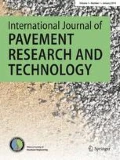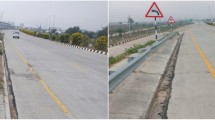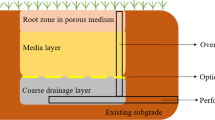Abstract
Rutting is one of the major distresses observed in bituminous pavements. In the majority of the design approaches including the Indian Road Congress (IRC) guidelines for the design of bituminous pavements, the rut depth is predicted by limiting the vertical compressive strain at the top of the subgrade. Here, due consideration is not given to the rutting in individual layers of pavement.
There are more than 20 variables that influence rutting in the pavement with the degree of influence of the variables differing for each layer. The analysis performed in this study is limited to the rutting observed in bituminous layers (HMA rutting) and the factors influencing it. Several factors influence the HMA rutting, and among them, traffic and climatic characteristics play a critical role. In this study, traffic data was collected for 12 National Highways across India, and appropriate weather stations were identified. Detailed weather data was collected for all these locations on an hourly basis. Using this information, simulations were carried out in AASHTOWare to generate the rut depth data. For the HMA rutting, it was seen that the pavement temperature distribution played a critical role compared to the maximum pavement temperatures. The degree of influence of Average Annual Daily Truck Traffic (AADTT) on the HMA rutting was, however, found to depend on the pavement temperature strongly.
Similar content being viewed by others
References
MoRTH, Basic Road Statistics of India 2015–2016. Government of India, Transport Research Wing, New Delhi, India, 2016.
NHAI, (NHDP, 2016). http://www.nhai.org/WHATITIS.asp. Accessed 18 october 2018.
Indian Roads Congress, Guidelines for the Design of Flexible Pavements. IRC:37-2012. New Delhi, India, 2018.
T. Fwa, S. Tan, L. Zhu, Rutting Prediction of Asphalt Pavement Layer using c-ϕ Model, J. Transp. Eng. 130 (5) (2004) 675–683.
S. Kim, M. Heitzman, L. Way, Sensitivity Study of Design Input Parameters for Two Flexible Pavement Systems Using the Mechanistic-Empirical Pavement Design Guide, Proc. 2005 Mid-Continent Transp. Res. Sympos., IOWA, August 2005, IOWA, USA, 2005.
R. B. Leahy, Permanent Deformation Characteristics of Asphalt Concrete, (Ph.D. thesis), University of Maryland, College Park, USA, 1989.
T. Kennedy, G. A. Huber, E. T. Harrigan, R. J. Cominsky, C. S. Hughes, H. L. Von Quintus, J. S. Moulthrop, Superior Performing Asphalt Pavements (Superpave): The Product of the SHRP Asphalt Research Program, Strategic Highway Research Program, National Research Council, Washington DC, USA, 1994.
R. Blab, J. T. Harvey, Viscoelastic Rutting Model with Improved Loading Assumptions, 9th Inter. Confer. Asphalt Pave., The Danish Road Directorate, Copenhagen, Denmark, 2002.
J. Hua, T. White, A Study of Nonlinear Tire Contact Pressure Effects on HMA Rutting, Inter. J. Geomech. 2 (3) (2002) 353–376.
N. Hossain, D. Singh, M. Zaman, Sensitivity of Traffic Input Parameters on Rutting Performance of a Flexible Pavement using Mechanistic-Empirical Pavement Design Guide, Inter. J. Pave. Res. Techol. 9 (6) (2016) 450–459.
J. A. Deacon, F. N. Fin, W. R. Hudson, W. L. Hindermann, W. B. Warden, C. L. Monismith, Load Equivalency in Flexible Pavements, Assoc. Asphalt Paving Technol. Proc. 38 (1969) 465–491.
Y. H. Huang, Pavement Analysis and Design. 2nd Edition, New Jersey, Prentice-Hall, USA, 2009.
J. F. Corte, Y. Brosseaud, J. P. Simoncelli, G. Caroff, Investigation of Rutting of Asphalt Surface Layers: Influence of Binder and Axle Loading Configuration, Transp. Res. Rec. 1436 (1994) 28–37.
K. Hassan, K. Salama, R. W. Lyles, Effect of Heavy Multiple Axle Trucks on Flexible Pavement Damage Using In-Service Pavement Performance Data, J. Transp. Eng. 132 (10) (2006) 763–770.
CSIR, The Damaging Effects of Overloaded Heavy Vehicles on Roads, Technical report compiled by CSIR, Road and Transport Technology, New Delhi, India, 1997.
CIRCLY, CIRCLY 7.0 — Implementation of the Austroads Design Method. Mincad Systems Pty. Ltd, Richmond South, Victoria, South Africa, 2018.
MePADS, Mechanistic-empirical Pavement Analysis & Design Software (mePADS) Version 1.1. South African National Roads Agency, SANRAL, SA, 2007.
AASHTOWare, AASHTO-Mechamstic-Empirical Pavement Design Software. American Association of State Highway and Transportation Official, Washington DC, 2012.
M-EPDG, Guidelines for the Mechanistic-Empirical Design for New and Rehabilitated Pavement Structures. NCHRP, Transportation Research Board, Washington, D.C, 2004.
A. Banerjee, J. P. Aguiar-Moya, J. Prozzi, Calibration of Mechanistic-Empirical Pavement Design Guide Permanent Deformation Models, Transp. Res. Rec. 2094 (2009) 12–20.
G. E. Jannat, X. X. Yuan, M. Shehata, Development of Regression Equations for Local Calibration of Rutting and IRI as Predicted by the MEPDG Models for Flexible Pavements using Ontario’s Long-term PMS Data, Inter. J. Pave. Eng. 17 (2) (2016) 166–175.
D. Bhanoj, Proof-Checking of Bituminous Pavement Design Sections and Development of a Rutting Model. M. Tech. Thesis, Indian Institute of Technology Madras, India, 2016.
V.R. Techniche Private Limited, Axle load data collection. Internal report, Noida, India, 2015.
Indian Roads Congress, Dimensions and Weights of Road Design Vehicles. IRC:3-1983. New Delhi, 2009.
H. Wen, J. Peng, L. Xu-hong, H. Jie, Site Survey and Analysis of Highway Trucks Overloading Status Quo in Anhui, J. Eastern Asia Soci. Transp. Studies 6 (2005) 1790–1803.
IMD Pune, Data Collected from Indian Meteorological Department, Pune, India, 2011.
Central Ground Water Board, Ground Water Scenario in Major Cities of India. Ministry of Water Resources, Government of India, 2011.
M. R. Nivitha, J. M. Krishnan, Development of Pavement Temperature Contours for India, J. Instit. Eng. (India): Series A 95 (2) (2014) 83–90.
Federal Highway Administration, Guide to LTPP Traffic Data Collection and Processing, FHWA, Washington, DC, 2001.
R. C. Srivastava, H. Pandey, Estimating Angstrom-Prescott Coefficients for India and Developing a Correlation between Sunshine Hours and Global Solar Radiation for India, ISRN Renewable Energy (2013) 403742.
MoRTH, Ministry of Road Transportation and Highways: Manual for Construction and Supervision of Flexible Works, Indian Roads Congress, New Delhi, India, 2013.
Bureau of Indian Standards, Indian Standard Specification for Paving Bitumen. IS:73. New Delhi, India, 2013.
American Society for Testing and Materials, Standard Specification for Viscosity-Graded Asphalt Cement for use in Pavement Construction. ASTM D3381. ASTM International, West Conshohocken, PA, 2013.
American Society for Testing and Materials, Standard Practice for Compaction of Prismatic Asphalt Specimens by Means of the Shear Box Compactor. ASTM D7981. ASTM International, West Conshohocken, PA, 2015.
American Association of State Highway and Transportation Officials, Standard Method of Test for Determining Dynamic Modulus and Flow Number for Hot Mix Asphalt using the Asphalt Mixture Performance Tester (AMPT). AASHTO T 378. Washington, D.C, 2017.
Acknowledgment
The authors thank M/s V.R. Techniche, Noida for sharing the traffic and axle load data.
Author information
Authors and Affiliations
Corresponding author
Additional information
Revised version of a paper presented at 15th World Conference on Transport Research (WCTR), Bombay, Mumbai, India, 26–31 May 2019.
Rights and permissions
About this article
Cite this article
Savio, D., Nivitha, M.R. & Krishnan, J.M. Influence of climate and traffic on the HMA rut-depth for India. Int. J. Pavement Res. Technol. 12, 595–603 (2019). https://doi.org/10.1007/s42947-019-0071-7
Received:
Revised:
Accepted:
Published:
Issue Date:
DOI: https://doi.org/10.1007/s42947-019-0071-7




